![]()
![]()
![]()
Use LEFT and RIGHT arrow keys to navigate between flashcards;
Use UP and DOWN arrow keys to flip the card;
H to show hint;
A reads text to speech;
35 Cards in this Set
- Front
- Back
|
T or F:
Salivary glands get larger the farther away that they are from the buccal mucosa. |
True!
|
|
|
Do salivary glands have an endocrine function, exocrine function, or both?
|
Exocrine
|
|
|
T or F:
One major difference between major and minor salivary glands is the presence of a distinct capsule in the major glands. |
True
|
|
|
Name some functions of the salivary glands, yo.
|
Moisten mucous membrane and food.
Lubricate and cleanse oral cavity. Aid in taste. Initiate digestion. Aid in swallowing. Adjust upper GI pH Secrete antibacterial agents |
|
|
T or F:
Amalyse is a common component of saliva in domestic species. |
False!
The pig is the only domestic species with salivary amylase of any consequence |
|
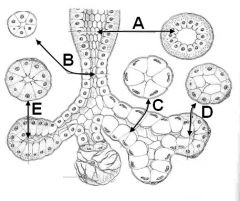
Identify these parts of a stylized salivary gland.
|
A - Striated duct
B - Intercalated duct C - Mucous adenomere D - Mucous adenomere with serous demilune cells E - Serous adenomere |
|
|
What are the subdivisions of a salivary gland called?
|
Lobules
|
|
|
What are the secretory cell types found in salivary glands? What are their histological characteristics?
|
Serous cells - acidophilic, basal round nuclei
Mucous cells - less acidophilic; basal FLAT nuclei |
|
|
Which cells squeeze salivary acinii?
|
Myoepithelial cells
|
|
|
Trace a salivary duct from the acinus to excretion
|
Acinus
Intercalated duct Striated (intralobular) duct Interlobular duct Intralobar duct Interlobar duct Excretory duct |
|
|
T or F:
Striated ducts are lined by bistratefied cuboidal epithelium. |
False, actually!
Striated ducts are simple columnar. Bistratefied (columnar/cuboidal) occurs at the transition between intralobular and interlobular ducts. |
|

Vanna, what type of gland do you have for us tonight?
|
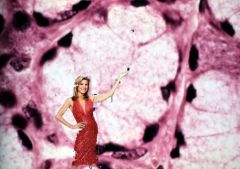
It's a necklace!
No, you dumb bitch - it's a mucous adenomere! |
|
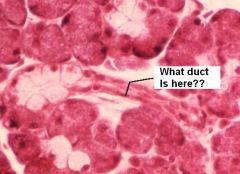
|

Intercalated duct
|
|
|
What is the function of intercalated ducts?
|
Modifies primary saliva.
The striated duct modifies the secretory product by reabsorbing Na+ and Cl– from the saliva and secreting K+ and bicarbonate into it, thus converting primary saliva to secondary saliva. |
|
|
What are some examples of major salivary glands? What does each predominantly secrete? Which type is uniform across species?
|
Parotid - serous
Mandibular - mucous (mixed in horses, humans, ruminants) Sublingual - mucous (mixed in humans, horses, and small carnivores) Zygomatic - ALL SPECIES - mucous w/serous demilunes |
|
|
T or F:
Parasympathetic stimulation results in dilute (serous) saliva. |
True!
Sympathetic works in concert to lessen the secretion of mucous saliva. |
|
|
How much saliva does a human produce (daily)? How 'bout a horse? A cow?
|
500mL
1-4L 90-190L!!! |
|
|
T or F:
The intercalated duct modifies primary saliva by reabsorbing Na, Cl and secreting K and HCO3. |
False!
Read the question better....it's the STRIATED DUCT that does this! |
|
|
What is the tonicity (relative oncotic potential) of primary saliva with respect to blood plasma?
|
Isotonic!
|
|
|
Is the pancreas exocrine, endocrine, or both?
|
Both!
|
|
|
What are some components of pancreatic digestive fluid?
|
Enzymes (amylase, lipase)
Proenzymes (trypsinogen, chymotrypsinogen, elastase) Bicarbonate (produced by ducts) Tripsin inhibitor |
|
|
T or F:
The bicarbonate component of pancreatic digestive fluid is produced by striated ducts. |
False! Striated ducts are ONLY in salivary gland tissue. Bicarb in the pancreas is produced by ductular epithelial cells.
|
|

Identify the tissue type. How do you know?
|
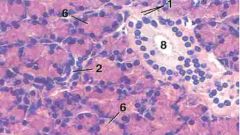
Salivary gland. 8 identifies the lumen of a striated duct.
|
|
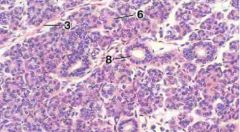
ID the tissue
|

Salivary gland
|
|
|
What type of tissue comprises the capsule of the pancreas?
|
Dense, irregular CT (like pretty much every other capsule)
|
|
|
T or F:
The CT of pancreatic septa is continuous with that of the capsule. |
True dat.
|
|
|
Describe the pancreatic ducts from acinus to excretion into the duodenum.
|
Acinus
Intercalated duct Interlobular duct Main and/or accessory pancreatic duct(s) |
|
|
Describe a pancreatic acinus stained by H & E.
|

Basally located round nucleus surrounded by basophilic cytoplasm (increased RER). Note the secretory granules (zymogen granules) at the apex (lumen side) of the acinar cells.
|
|
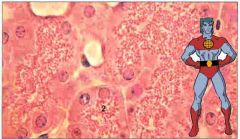
Earth, Fire, Wind, Water, Heart, and....what type of tissue is this?
|

Pancreas. Note the acidophilic granules in the acinus.
|
|
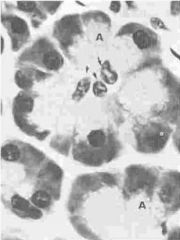
What tissue type?
What are cells at the center of this acinus called? What structure are they a part of? |

Pancreas
Centroacinar cells from intercalated duct |
|
|
What receptors are found on centroacinar and intercalated duct? What produces the ligands for these receptors?
|
Secretin - from enteroendocrine cells in small intestine
ACH - parasympathetic innervation |
|
|
What is the lining of intercalated ducts? How about interlobular ducts?
|
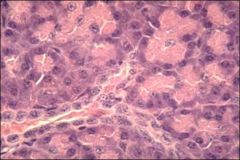
Simple (low) cuboidal for intercalated duct (shown in image).
Tall columnar for interlobular duct. |
|
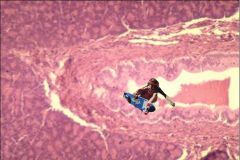
Damn! Tony Alva will grind anything! Where is he anyhow and how do you know?
|

Interlobular duct of the pancreas.
Note acidophilia in the parenchyma and the tall columnar epithelium of the duct. |
|
|
What sensory structure is found in the pancreas?
|
Pacinian corpuscle.
|
|
|
Where does pancreatic carcinoma chiefly originate from?
|
The ducts (>80% in humans)
|

